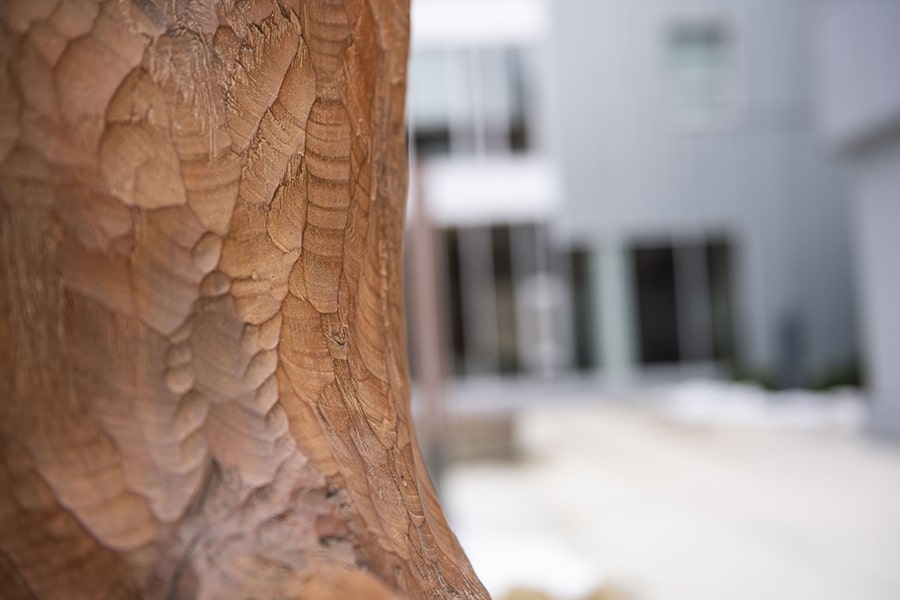Fifth and Clyde Courtyard Is Stage for Celebrated Pittsburgh Artist
Inverted Dancer by Thaddeus Mosley is the newest addition to the campus experience
By Rachel Latsko
Bringing public art to campus infuses it into the everyday environment and lives of the Carnegie Mellon University community.
“CMU’s newest residence hall, Fifth and Clyde House, and the Fifth Avenue Neighborhood Commons offer a perfect space for CMU’s latest public art installation — an outdoor courtyard for all to enjoy,” said Thomas Cooley, executive director of Housing Services, which is funding this public art project.
Thaddeus Mosley’s “Inverted Dancer” is a gravity-defying, 8 ½ feet tall bronze sculpture made from reworked wood, and what Mosley describes as “sculptural improvisations.” He sculpts while listening to jazz, participating in “a cross-disciplinary dialectic of spontaneity and intuition.”
“’Inverted Dancer’ evokes the serenity and harmony of the natural world and the grace of a dancer's body. It anchors the contemplative and social space in the courtyard of the building,” said Elizabeth Chodos, assistant professor of curatorial practice, director of the Miller Institute of Contemporary Art and CMU’s public art curator.
 Using only a mallet and chisel, Mosley collaborates with found knots and striations in the wood, respecting its history and employing it to add texture to his visual music.
Using only a mallet and chisel, Mosley collaborates with found knots and striations in the wood, respecting its history and employing it to add texture to his visual music.
CMU requires all new construction projects to include some public art to enhance and engage the community, integrating the design of the interior and exterior spaces.
“The more people live with art as a part of their daily lives, the more they will experience the value and benefit of what artists contribute to society,” Chodos said. “It's been such an honor to have the opportunity to enrich campus in this way.”
“’Inverted Dancer’ evokes the serenity and harmony of the natural world and the grace of a dancer's body.” — Elizabeth Chodos
The selection and approval of public art is a rigorous process, including review and approval through the Public Art Committee, a public town hall meeting, and final approval from CMU President Farnam Jahanian.
Finding a piece the students would love for this space and setting a high bar for the caliber of art housed on campus was important to everyone – Chodos, Housing Services and Campus Design and Facility Development.
Mosley was the perfect fit for the historic Fifth Avenue location.
Born in New Castle, Pennsylvania, and a graduate of the University of Pittsburgh, the self-taught sculptor creates monumental abstract works from segments of salvaged wood, sourced from local Pittsburgh construction facilities, sawmills and the city’s Forestry Division.
Watch this time-lapse video of workers installing Thaddeus Mosley's "Inverted Dancer" in the Fifth Clyde House courtyard.
Even before Mosely began sculpting, he was “drawn to African-American art.”
“Then I quickly grew from being interested in it to being exhilarated by the energy and inventiveness of those countless objects, made unselfconsciously by anonymous people as a part of their lives,” Mosley said in the book “Thaddeus Mosely: African-American Sculptor,” published jointly by the Carnegie Museum of Art and the University of Pittsburgh Press.
His work is inspired by his medium and his sculpting tools.
“I never made drawings. I draw with a hammer and chisel. It's a sculptural improvisation, a journey,” Mosely said.
Using only a mallet and chisel, Mosley collaborates with found knots and striations in the wood, respecting its history and employing it to add texture to his visual music.
The Hill District is home to Mosley’s best-known sculptures – the 14-foot cedar Phoenix at the corner of Centre Avenue and Dinwiddie Street, and the “Mountaintop” limestone at the Martin Luther King, Jr. Library.
“I draw with a hammer and chisel. It's a sculptural improvisation, a journey,” — Thaddeus Mosely
Mosley’s work has appeared in Pittsburgh’s Mattress Factory Museum and the Carnegie Museum of Art, in addition to being exhibited and acquired by major museums and foundations across the country since 1959. His sculptures mark an inflection point in the history of American abstraction.
Mosley has served as a board member of The August Wilson African American Cultural Center and as an officer of the Pittsburgh Society of Sculptors. He was named Artist of the Year in Pennsylvania Visual Arts, and received the Cultural Award, the Governor’s Award and the Guild Council Service to the Arts Award by the Pittsburgh Center for the Arts.
“It’s truly wonderful that Thad’s work will now be a part of the students’ everyday lives, breaking the boundaries of the classroom and forging a deeper connection to the city they are a part of,” said Charlie White, professor and head of CMU’s School of Art.
Chodos said art can transform the way we think, feel and as a result, the way we behave and interact with the world around us.
“The multi-disciplinary nature of the creation of the sculpture with equal parts jazz music and the medium of carved wood is a good analogy to the way that people from different disciplines at Carnegie Mellon, many of whom would not otherwise interact, are brought together through housing and the residential experience,” said Karen Whirley, a junior majoring in mechanical engineering with minors in biomedical engineering, robotics, and innovation and entrepreneurship.
“’Inverted Dancer’ sets a tone of reverie and playfulness and asks you to pause, reflect and to take the time to look a little closer,” Chodos said.

 At Carnegie Mellon University, art created by members of the Tartan community and others is woven into the fabric of everyday life. An intentional wayfarer can find unexpected treasures along with iconic imagery that is just so CMU.
At Carnegie Mellon University, art created by members of the Tartan community and others is woven into the fabric of everyday life. An intentional wayfarer can find unexpected treasures along with iconic imagery that is just so CMU.